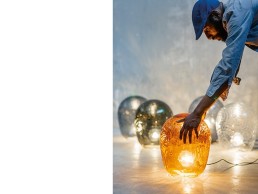
Brimet Silva – DigitaLAB
The Portuguese lighting sector is made up of more than 200 companies, employing over 3,000 people. Made up of small and medium sized brands, which some might consider a handicap for internationalisation, the country managed to export over €120m in 2018, doubling its exports compared to the major economic crisis of 2009. Over the next few pages darc provides you with a deeper understanding of lighting designs coming out of the country, while profiling a selection of stunning decorative lighting brands.
Under the umbrella brand of LUZZA, AIPI Portuguese Lighting Association works to promote the greatest brands of the Portuguese lighting industry. Combining the highest standards of European production with innovation, uniqueness and original design, LUZZA aims to support and promote Portuguese brands at an international level. As part of our Portugal design report, LUZZA asked Designer Brimet Silva of creative lab, architectural office and design studio DigitaLAB, to provide an insight into the country’s lighting sector and what makes Portuguese design so special.
How has the design industry in Portugal changed?
Brimet Silva: The design industry is somewhat binary. On the one hand, we have an industry with huge know-how that produces for leading international brands, using highly skilled artisans or the most advanced manufacturing technologies. On the other hand, there is still some hesitation in investing in Portuguese brands, as it remains a risky option and the vast majority of manufacturers and investors fail to realise the importance of design and creativity in society and the economy. This is because design in the national territory is underappreciated, a fact across the entire ecosystem. Lighting is no exception, I would even say that there is a huge way to go. Design in Portugal is taking its first steps and lighting is still a brave new world – there is still a lot to do and the best is yet to come.
What product trends are you seeing come out of Portugal?
There is no design style in particular. In this embryonic phase of lighting design we see a wide range of styles and influences. We may eventually divide the national state of the art into four major groups. The first group develops more technical lighting for contract design, exploiting the latest potential of LEDs, more sophisticated materials and sometimes using Bluetooth technology.
It is a small number, but the amount of international awards these companies have already won is remarkable. In the second group, we can see a clear influence of modernist design; revivals present in the shapes of the products and the materials used.
In the third group, we observe a strong connection with handcrafts and cultural traditions. With very variable scales, companies rely on the expertise of artisans in the work of glass, metals, porcelain and so on, to create unique pieces, sometimes resorting to almost extinct practices and processes.
Finally, there is a new generation of designers who have adopted a more exploratory, experimental and disruptive design. Devoid of slogans, these recent practices explore convergences between different materials, styles and production processes. As a result the pieces gain a more sculptural character, where light is more dream-like.
The overall picture remains very heterogeneous; it would be premature to specify a lighting trend. But it seems clear to me that materials such as cork, porcelain and marble are beginning to gain greater prominence, joining more classic materials such as glass, brass, metals, fabrics and so on.
Does Portuguese culture play a role in design style?
The presence of Portuguese culture in design seems to be unavoidable, but I do not believe it is a concept based on copy and paste. I identify a reinterpretation of the culture present in materials and functionality of design pieces. Identity plays a crucial role in differentiating a country’s design in an increasingly globalised world. It is this individuality that characterises and values us.
How strong is decorative lighting in Portugal?
It has huge potential. For many years, old generations have always acquired timeless pieces that passed from generation to generation. Nowadays, young people have retained this habit, not with the same degree of investment and durability, but in the valorisation of decorative light as an essential element in the comfort of the space. Interior designers have long realised the importance of this paradigm and a consistent lighting design is the beginning of a balanced interior space where light creates environments and promotes emotions.
What’s next for design in Portugal and how do you see lighting playing a role as part of that?
Design in Portugal continues a process of great development and affirmation. It will be a long and complex process, but absolutely necessary. It is vital to value not only ‘Made in Portugal’ but also ‘By Portuguese Designers’. Development only makes sense if it is transversal. Industry, designers, investors, marketers and the media have to work together for a greater appreciation of Portuguese design. There is a spirit of great enthusiasm and optimism. The economic crisis is part of the past and the country is already a world reference in the tourism area. It is vital to use this ‘state of grace’ to promote and communicate best practices of Portuguese design, spreading new brands, designers and concepts. Lighting design is changing and international brands are exploring light in an increasingly experimental way. This great conceptual opening can be the gateway to the new Portuguese design that combines the know-how of its identity with new lighting experiences.



